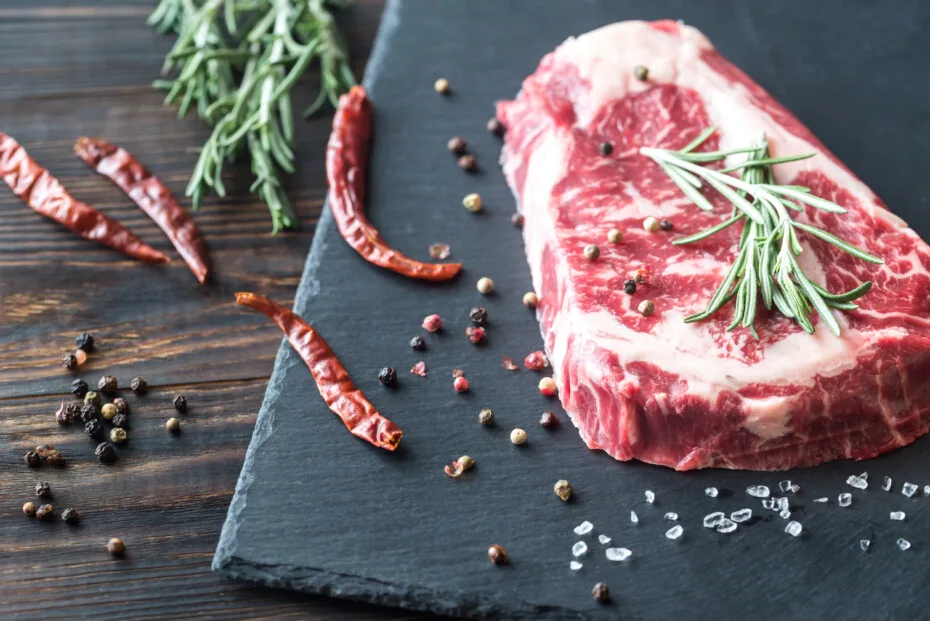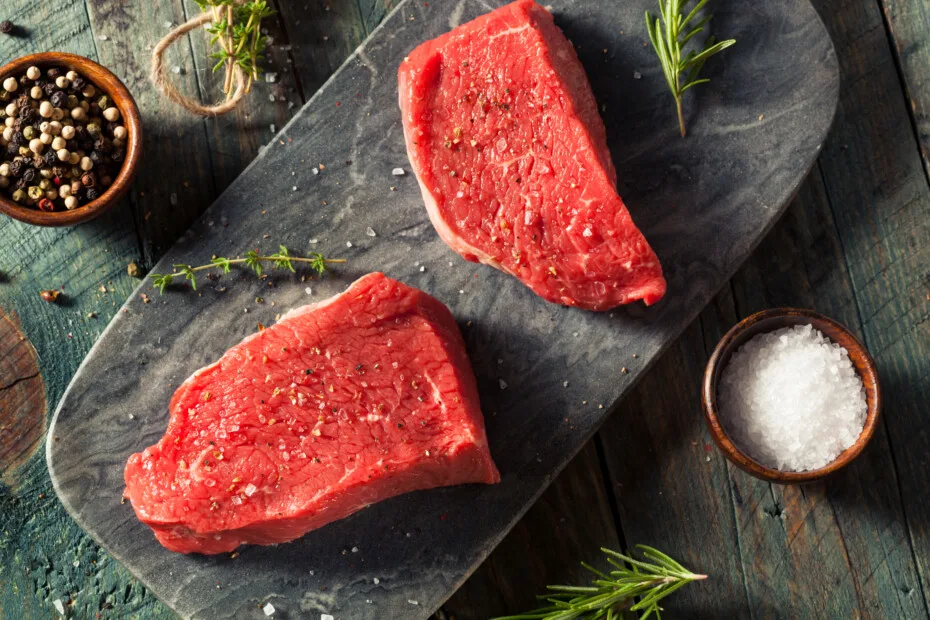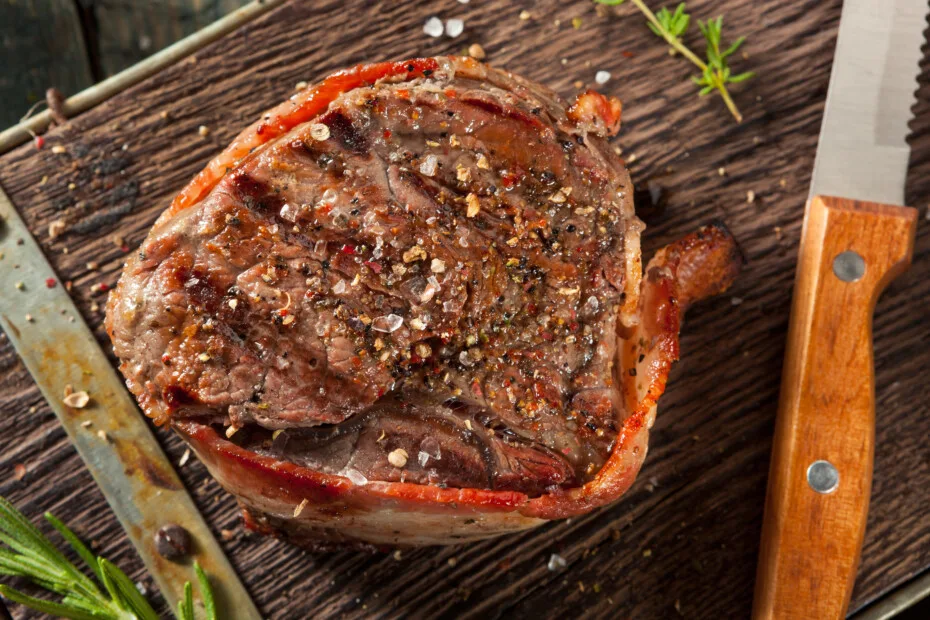Here we are again, another heavyweight championship between two prized contenders in the steak world. The battle is on between sirloin and ribeye.
Both opponents have a good chance of winning this competition.
However, let’s examine why these two steaks are truly the best contenders for this match.
Contents
What Is a Ribeye Steak?
The ribeye steak is fabricated from the rib, a sub primal cut of beef.
The ribeye is positioned between the chuck or shoulder and the loin. It is also fabricated from ribs six to twelve.
The ribeye is regarded as one of the greatest steaks on the market. It contains heavy amounts of intramuscular fat.
The flecks of intramuscular fat melt as the ribeye is cooking, preventing the meat from drying out.
The fillet of longissimus dorsi muscle does not receive a lot of use during the steer’s life. Therefore, the muscle retains its tenderness and beefy flavor.
Ribeye steaks usually come with a portion of the spinalis muscle attached. This muscle is separated from the longissimus dorsi by a band of fat.
The spinalis muscle is laden with intramuscular fat and provides the steak with a succulent, moist, and flavorsome punch.
As a stand-alone dish, the spinalis would be extremely fatty. However, it pairs particularly with the leaner muscles of the ribeye.
Ribeye can be purchased bone-in or boneless.
Bone-in ribeye are usually called a cowboy steak or tomahawk steak when the full rib bone is left in and Frenched.

What Is a Sirloin Steak?
The sirloin is a bigger sub primal cut of beef that is fabricated into several other cuts, including the T-bone steak, top sirloin, and bottom sirloin.
Sirloin steaks are usually cut from the top sirloin.
Dissimilar to the ribeye steak, the sirloin has a lower fat content. As a result, the sirloin does not have the signature layer of marbling as the ribeye.
Thus, some individuals may find it to be less flavorful and less tender than the ribeye.
Although it is trimmed of the surrounding layer of fat and connective tissues, sirloin steaks are still boasting with beefy flavor.
You can also choose a dry-aged sirloin steak if you want a richer flavor.
Sirloin steaks are also labeled as New York Strip, Kansas City Strip, Omaha Strip, or a club steak.

Is Sirloin the Worst Steak?
Sirloin steaks are one of the most advertised steaks in the restaurant industry.
Some people regard sirloin as the worst cut of steak.
However, it depends on whether it was cut from the top or bottom sirloin.
Top sirloin steak is not as tender as its counterparts. However, it is an inexpensive cut of meat known for its chewy texture.
Some people confuse the top and bottom sirloin steaks. It’s actually the bottom sirloin is that is regarded as the worst cut of sirloin due to its quality.
Sadly, bottom sirloin served as steak will certainly not be the slightest bit tender. This is why it is best to use bottom sirloin for soups and stews.
Whether it is top or bottom sirloin, it requires a little more tender loving care.
The trick is to undercook it to combat some of its chewiness.
Differences Between Sirloin and Ribeye Steaks
Declaring one cut of steak the superior choice is a difficult decision.
After all, all steaks are not made the same. There are a few major differences you should be aware of before making your decision.
Flavor and Appearance
The flavor profile of a steak heavily depends on the ratio of fat to meat.
For example, a ribeye steak a higher quantity of fat that gives the steak more flavor.
In contrast, though not as fatty, sirloin steaks can be dry ages, increasing the flavor and tenderness of the meat.
Nutritional Value
Sirloin is by far the healthier choice. One 3 oz. serving of sirloin is 150 calories, while 3 oz. serving of ribeye is 190 calories.
This difference in calories is due to ribeye’s fat content.
Tenderness
When it comes to beef, location is everything. The ribeye is cut from the middle section of the rib.
The ribs barely perform much work. Even when the animal is walking, thus it’s super tender.
On the other hand, the sirloin is cut from the part of the animal that is in close proximity to the legs.
As a result, these muscles are used more, making them leaner and tougher.
This does not mean that the sirloin is not tender. The trick is to slice the cooked sirloin against the grain to promote tenderness.
Versatility
As we have previously discussed, the ribeye is made up of two muscles.
These muscles contribute to the ribeye’s shape and price. For this reason, the rib eye is the headliner of the concert.
The sirloin has more uniformity in regard to shape and size. Its low price means there is more room to experiment.
You can cut sirloin into cubes, marinate, and thread it onto skewers to create steak kabobs, or use it to make beef stir fry or fajitas.
Price
Many determinants are factored into the pricing of steaks. The breed of cow, weight and quality rating are a few factors that affect the price of steaks.
However, the most important determinant of pricing is the quantity of marbling. Marbling is considered a treasure of the steak world.
The USDA’s ranking system hinges on the ratio of marbling.
The ribeye is the cut used to decide the grade of the entire animal.
Therefore, ribeye steaks are very likely to be deemed prime grade, which means you will pay more for a ribeye than a sirloin.
Cooking Methods
These two cuts are very different. One cooking method may work well with a ribeye steak, but it may not work well for the sirloin steak.
How Is Ribeye Best Cooked?
The best preparation technique for ribeyes is quick cooking methods that use direct heat.
The marbled meat of the ribeye is perfect for searing, broiling, or grilling.
The layers of fat promote moisture while the steak develops a deeply golden crust as it’s cooking.
The most popular of these methods is searing.
To sear your ribeye steak, salt them 24 hours in advance and chill them in the refrigerator.
Not only will the salt intensifies the flavor of the meat, but it pulls the excess moisture from the surface of the steak. Salting the steaks promotes even searing.
Place a skillet, preferably a cast-iron skillet, over medium-high heat.
Add a tablespoon of salted butter and two tablespoons of olive or canola oil and heat it in a scorching hot.
The combination of butter and oil not only adds flavor but it allows you to sear the ribeye at a higher temperature.
Place your steaks into the skillet, being careful not to overcrowd the pan.
Cook the steaks for 3-5 minutes on both sides until it achieves a temperature of 130°F for a perfect medium-rare.
Allow your ribeye to rest on a cutting board or plate for 5 minutes before carving and serving.
How Is Sirloin Best Cooked?
The ultimate cooking method for top sirloin steak is grilling. The sirloin is thinner than a ribeye.
It can absorb the smoky flavor of the grill without becoming dry and tough.
However, you can also pan-sear or broil your top sirloin steak.
You can also use a combination preparation method by cooking it sous vide, then searing it in a scorching hot skillet on the stove or grill.
This popular technique is known as reverse searing.
Reverse searing decreases the chance of overcooking the steak by ensuring it is the perfect medium-rare.
- Salt your top sirloin steaks 24 hours in advance and place them into the fridge.
- Place the sirloin on a wire rack set over a cookie sheet and place it into a 250°F. Cook the sirloin steak until it is 120°F.
- You can also cook your sirloin via sous vide by vacuum sealing it and cooking it in a sous vide cooking machine for 2-3 hours at 130°F.
- Remove the steak from the oven and let it rest until your skillet heats up.
- Place a skillet, preferably a cast-iron skillet, over medium-high heat. Add a tablespoon of salted butter and two tablespoons of olive or canola oil and heat it in a scorching hot, about 3-4 minutes.
- Place the sirloin steaks into the pan and cook it for 1-2 minutes until a rich crispy crust develops. Flip the sirloin over and cook it for another 1-2 minutes.
- Allow the steaks to rest for 2-3 minutes before serving.
Final Thoughts
Which cut of steak is the best? To be truthful, the answer is unclear. Every person has to decide whether the ribeye or sirloin is best.
The ribeye is tender and succulent with a delicious buttery flour produced by intricate marbling.
On the other hand, sirloin is the healthier choice.
Even though it’s not as tender as the ribeye, it is affordable, allows you to be creative, and gives you a healthy dose of beefy flavor.
You might also be interested in the following comparisons:
- Porterhouse Vs. Ribeye
- Tomahawk Steak Vs. Ribeye
- Porterhouse Vs. T Bone
- Filet Mignon Vs. Ribeye
- Prime Rib Vs. Ribeye
- Tenderloin Vs Filet Mignon
- Sirloin Vs. Tenderloin
- Filet Mignon Vs. Sirloin
- New York Strip Vs. Ribeye
- T-Bone Vs. Ribeye Steak
- New York Strip Vs. Sirloin

I have been smoking and grilling meat from an early age and enjoy sharing my knowledge and expertise through the hundreds of articles I have written about BBQ. I hope to make everyone’s BBQ journey that little bit easier.

